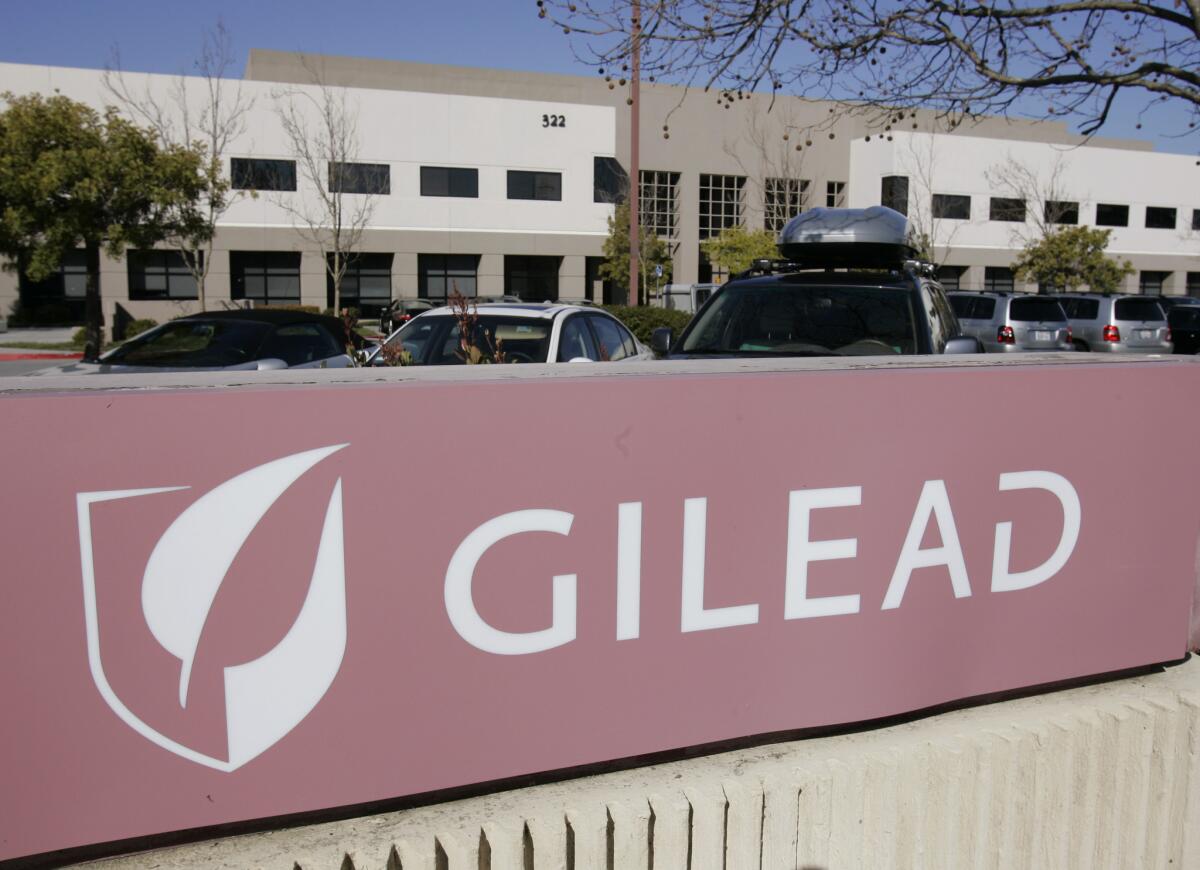New prescription drugs can help patients, but their high prices elicit ire

Gilead Sciences was charging $1,000 per pill for the hepatits C drug Sovaldi in 2013.
They sounded like three deadly strikes.
The patient had a dangerously high level of LDL cholesterol, a high risk for heart disease and an intolerance for the most common cholesterol-fighting medication.
Dr. William Averill, a Torrance cardiologist, thought he had a solution: Praluent, a cholesterol-lowering drug from pharmaceutical companies Regeneron and Sanofi that had just been approved by the FDA as a treatment for people who didn’t benefit from the standard cholesterol treatment.
The only problem? The drug’s $14,600-a-year sticker-shocker price — 140 times more expensive than generic statins that typically cost about $100 a year.
“He was the perfect first patient for me to prescribe it for,” Averill said. “When he heard the price, he went to get a second opinion.”
Averill hasn’t heard back.
Praluent is only one in a series of highly effective specialty drugs to recently hit the market with price tags that have angered insurers and patient advocacy groups.
In 2013, Gilead Sciences priced the breakthrough hepatitis C drug Sovaldi at about $84,000 for a 12-week treatment, or about $1,000 a pill. Last year, it released an even more effective drug, Harvoni, which had minimal side effects and a cure rate as high as 99%. Its price tag: nearly $100,000.
The debate intensified when Amgen Inc., the Thousand Oaks biotech giant, won Food and Drug Administration approval last month of its cholesterol drug, Repatha, which is similar to Praluent and carries a $14,100 annual price tag.
The injected drugs improve the liver’s ability to reduce LDL, the “bad cholesterol” tied to increased risk for heart attacks and strokes, by 50% or more. The drugs are cheaper than the hepatitis C treatments, but more people have dangerously high cholesterol — and because the condition is chronic, patients typically need to take medication for their entire lives.
Thus, the drugs could place a massive strain on insurers, and drive up premiums for companies and employees.
“This is a much more significant threat to healthcare affordability than the hepatitis C drugs are, and that’s saying a lot,” said Marcus Thygeson, chief health officer and senior vice president for Blue Shield of California.
------------
FOR THE RECORD
Sept. 21, 11:43 a.m.: An earlier version of this article gave the name of Blue Shield of California chief health officer and senior vice president as Marcus Theygeson. His name is Marcus Thygeson.
------------
What’s more, studies have yet to be concluded on whether the drugs actually reduce heart attacks and strokes, and not all working cardiologists are sold on them.
“The main thing to keep in mind right now is there’s no long-term data,” said Dr. Parveen Garg, a USC cardiologist. “How do we really measure a cardiac drug? Is it going to reduce cardiovascular mortality? Is it going to save lives? The data’s not there yet.”
Without that evidence, it’s difficult to gauge the correct price. “Is it worth it?” he said. “You don’t really know.”
Amgen has strongly defended the pricing of its drug, stressing its value to patients who aren’t getting good results from statins.
“Repatha addresses the No. 1 killer of humans on the planet,” said Sean Harper, Amgen’s executive vice president of research and development.
At the center of the debate about specialty drugs is the key question: If a new drug will cure a disease, or save lives, what is its proper cost?
And few companies have faced as much scrutiny as Gilead Sciences after it released Sovaldi at $1,000 a pill. California officials said they expect the drug to cost the state $300 million a year, including treatment of prisoners and Medi-Cal enrollees.
In July 2014, a Senate committee sent a letter to the Northern California company, asking for an explanation of the pricing. Philadelphia’s transit authority even sued Gilead last year, calling the pricing excessive. A federal judged dismissed the lawsuit in May.
Gilead has defended the pricing, noting that its drugs cure hepatitis C without the side effects of previous treatments.
“Harvoni and Sovaldi offer a cure at a price that reduces hepatitis C treatment costs now and will deliver significant savings to the healthcare system over the long-term,” the company said. “We believe the prices of Harvoni and Sovaldi reflect the value of the medicines.”
Deciding whether to cover the costs of the new medications is an issue for insurers. This year, a West Hollywood woman sued Anthem Blue Cross for refusing to cover the estimated $99,000 it would cost to treat her hepatitis C with Harvoni.
In a denial letter, Anthem explained that the drug was “not medically necessary” because the woman did not have advanced liver damage, the lawsuit said.
Shima Andre, the patient, said she was devastated by the decision.
“I can’t believe that they demand that a person get sicker before they’ll pay for a cure,” she said. “If there’s a cure for something and you have health insurance, they should cover it.”
Anthem Blue Cross spokesman Darrel Ng declined to comment on the lawsuit, which is pending in Los Angeles County Superior Court.
Robert Zirkelbach, senior vice president of Pharmaceutical Research and Manufacturers of America, a drug industry trade group, said insurers and other critics often lose sight of the significant benefits of this new class of drugs.
“Too often, the entire discussion is about the cost of these medicines and largely ignores the tremendous value they provide to patients,” he said. “New medicines are coming to the marketplace that are completely transforming how cancer is treated in this country. Hepatitis C is now cured in 90% of patients. That is nothing short of groundbreaking.”
He argued that developing these drugs is very expensive, so the drugs that make it to the marketplace need to reward that risk and help fund future research.
“If you arbitrarily cap the prices that can be charged for a medicine, that’s going to have a significant impact on the ability of companies to develop the next generation of medicine,” Zirkelbach said.
But Steven D. Pearson, founder and president of the nonprofit Institute for Clinical and Economic Review, said it’s not really clear how drug manufacturers set list prices.
“It feels like a magical process,” said Pearson, who founded the organization seven years ago at Harvard Medical School to study new drugs and medical services.
Many factors should play a role in pricing, but he says the primary focus should be on the value to patients.
“It’s not so much a question of price; it really is about value,” he said. “It may be high prices are completely justified based on the benefit they can bring patients.”
Pearson said the problem with the new cholesterol drugs is “the costs are out of alignment with the clinical benefit.”
His group issued a report this month that concluded the true value of the drugs is $3,600 to $4,800 a year, about one third of their list price. The pricing would need to be even lower — about $2,200 — for insurers to be able to afford to cover them.
Insurers seized on the report to criticize the makers of the cholesterol drugs.
“We had expected these drugs would be priced quite expensively, like other specialty drugs, and they would be priced way above their health value,” said Thygeson of Blue Shield of California. “The report from ICER pretty much confirms that that’s the case.”
Amgen contends the report failed to consider the hundreds of billions of dollars that are spent each year treating cardiovascular disease.
“We are concerned that ICER’s review does not place value on addressing a significant unmet medical need, and its short-term budgetary focus will be used to create access barriers to innovative medicines like Repatha for appropriate patients,” the company said in a statement.
Sanofi defended the pricing of its cholesterol drug, Praluent.
“Praluent is one of the most significant medical breakthroughs in the treatment of high bad cholesterol, a major risk factor of heart disease, since the introduction of statins nearly 30 years ago. ICER’s report inadequately characterizes cardiovascular risk in the approved patient population for Praluent in the U.S., and their conclusions underestimate the value Praluent brings to patients and the healthcare system,” the company said.
SIGN UP for the free California Inc. business newsletter >>
Michael Yee, a biotech analyst with RBC Capital Markets, said much of the pricing criticism is unfair, and driven by insurers. He said the debate about new cholesterol drugs is a good example.
“The problem is everyone wants to get the good drug at the same price as the old drug,” he said. “Why should they be punished when the drug is significantly better? Shouldn’t they be rewarded?”
Last year, the Tufts Center for the Study of Drug Development estimated that drug companies, on average, spend about $2.6 billion to develop a medication that’s ultimately approved by the FDA.
But they’re not all that expensive. Pharmasset Inc. said it spent $63 million developing Solvaldi from 2009 to 2011. The promise of the drug was a major reason Gilead Sciences bought the New Jersey company for the substantial sum of $11 billion in 2011.
The debate is so intense that the high cost of new drugs is likely to become an issue in the upcoming presidential election.
Bernie Sanders, the Vermont senator who is running for president, said he would introduce legislation to let the Department of Health and Human Services negotiate drug prices with pharmaceutical companies.
“Using the buying power of the federal government to get better deals on drug prices for taxpayers and seniors on Medicare would dramatically lower the costs,” Sanders said.
Pearson, the nonprofit research group founder, said it’s clear that pharmaceutical companies need to make money to continue searching for new medical breakthroughs, but there has to be limits.
“Everybody would agree we want a lot of investment flowing into the search for better drugs,” he said. “We all have to agree it’s not a blank check.”
Twitter: @spfeifer22
ALSO
Unlikely allies are joining the quest to save the imperiled sage grouse
New York subway watchdog hopes Pope Francis climbs aboard
Eastside housing group under fire from gentrification foes
More to Read
Inside the business of entertainment
The Wide Shot brings you news, analysis and insights on everything from streaming wars to production — and what it all means for the future.
You may occasionally receive promotional content from the Los Angeles Times.











